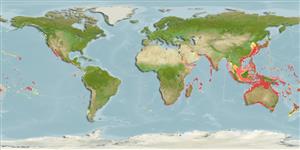Common names from other countries
Classification / Names / Names
Common names | Synonyms | Catalog of Fishes (gen., sp.) | ITIS | CoL | WoRMS
Environment: milieu / climate zone / depth range / distribution range
Ecology
Benthic; depth range 0 - 150 m (Ref. 7727). Tropical
Circumglobal tropical and temperate seas.
Length at first maturity / Size / Weight / Age
Maturity: Lm ? range ? - ? cm Max length : 3.0 cm TL male/unsexed; (Ref. 844)
Often with small flat shell remnant hidden in mantle above digestive gland. Color ranges from translucent pale yellow to bright red; back covered with small white gland cells which secrete milky white secretion as a defense mechanism.
Assumed maximum length from Ref. 844. Known from depths of 0 to 150 m (Ref. 7727); and at shallow subtidal depths under boulders on reefs; shells to 40 m (Ref. 337) and in rock pools up to 2 m. Hides under rocks at daytime, active at night (Ref. 844). Reported as a scavenger (Ref. 866) and as feeding on a variety of sponges and three species of corals, i.e., Tubastrea coccinea, Leptastrea sp. and Porites lobata (Ref. 84066).
Life cycle and mating behavior
Maturity | Reproduction | Spawning | Eggs | Fecundity | Larvae
Members of the order Notaspidea are mostly simultaneous hermaphrodites.
Burn, R. 2006. (Ref. 7727)
IUCN Red List Status (Ref. 130435)
CITES status (Ref. 108899)
Not Evaluated
Not Evaluated
Human uses
| FishSource |
Tools
More information
Age/SizeGrowthLength-weightLength-lengthMorphologyLarvaeAbundance
Internet sources
Estimates based on models
Preferred temperature
(Ref.
115969): 15.1 - 28.8, mean 26.1 (based on 1478 cells).
Vulnerability
Low vulnerability (10 of 100).
Price category
Unknown.
